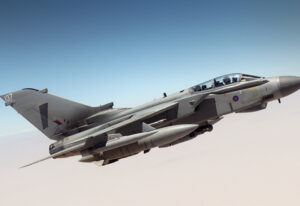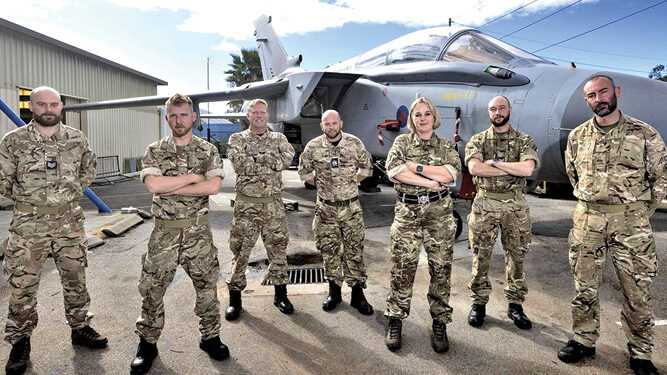Charles Page
On 17 January 1991, RAF pilot John Peters and Weapon Systems Officer (Wizzo) John Nichol were shot down over Iraq, and taken POW. Nichol recalls:
‘We were on our way out of the target area, and suddenly there was a massive explosion. A missile hit the back of the aeroplane, and it was like being hit by an express train, and I survived that because of the Tornado.
It was a massive piece of equipment. It was a hard and sturdy beast. It took a hell of a beating. It was on fire. The wings were on fire. The ammunition was cooking off. The flames were coming around, and do you know what? That old bird was still flying.
It was heading home, and do you know what we could have stayed on board a bit longer. That aircraft was on its way home. It was still flying, despite almost every piece of equipment and every piece of flying control burnt out, it was still flying, heading home.’
This iconic warbird was designed and built by Panavia, a consortium formed in 1969 by UK, West Germany and Italy. There was a need for a multi-role combat aircraft, and this led to a swing wing design. The Tornado was not the first swing wing design, as this originated in a WWII German design, with wing sweep that could only be changed on the ground. This led to the Bell X-5, F111, Sukhoi 17, MIG 23, Tupolev TU22, SU-24, F14, Mig 27, B-1B Lancer, and TU 160. Certainly, Barnes Wallis, inventor of the Upkeep Mine (Bouncing Bomb) played a major role in pioneering the swing wing.
Three versions of the Tornado were produced: the ECR reconnaissance version, the ADV fighter version F2 and F3, and the IDS interdictor strike aircraft. British Aircraft Corporation in the UK built the front fuselage and tail assembly, while Messerschmitt-Bölkow-Blohm in West Germany built the centre fuselage, and Aeritalia in Italy built the wings. The Turbo-Union engines were constructed by Rolls Royce, MTU Germany, and Fiat.
The first flight took place on 14 August 1974, and a total of 990 Tornados were built, making it one of the most successful multi-national aircraft designs. It operated with the Luftwaffe, the Italian Air Force, the Royal Saudi Air Force, and the RAF. The first RAF Tornados were delivered 1 July 1980.
The RAF bought 165 F2s and F3s, and 230 of the IDS, which they designated as GR1 ground attack versions. In later years, 142 of the GR1s were upgraded to GR4s. The GR1 was designed as a Cold War warrior for attacks on East German airfields and infrastructure, using terrain following radar, and armed with four tactical nuclear weapons. During Gulf War I, the GR1s reverted to medium level, with laser targeting.
The Tornado had a maximum speed of Mach 2.2, courtesy of two Turbo-Union RB 199 engines with afterburners. Maximum Speed, at 9,000 m (30,000 ft) was 1,300 knots (1500 mph, 2400 km/h). Maximum speed at sea level was 1,482 km/h, 800 knots, 921 mph. Service Ceiling was 50,000 ft (15,240 m).
The wing sweep could be manually varied between 25° and 67°. Surprisingly, the Tornado had no ailerons, and both roll and pitch were controlled by tailerons. There were two airbrakes on the upper fuselage, and the wing slats and flaps, spoilers and reverse thrust enabled short landings. There was also an arrester hook for emergency landings.
Hard points under the wings and fuselage allowed for two drop tanks, and another two could be carried for ferry flights. There was also a retractable refueling probe in the nose, and a fuel dump outlet in the tailfin. A variety of ordnance could be carried, such as JP233 runway bombs, ASRAAM air to air missiles, Storm Shadow cruise missiles, Brimstone anti-tank missiles, RAPTOR recon pod, TIALD laser designator, and two Mauser 27 mm cannon (one on the GR4). The Tornado was well known as the ‘Tonka’ or ‘The Mighty Fin’ or ‘The Flying Fin’ (the fin was six meters, or 20 feet tall). The Tornado served for 40 years with the RAF, through the Cold War and then the Middle East. It was continuously deployed on operations from 1990 in Iraq, Syria, Afghanistan, Libya and the Balkans.
With the RAF Tornado GR4s being retired from service in 2019, museum manager Trevor Fettis sought to obtain one for the Aviation Heritage Museum of Western Australia. ‘I decided to email a letter to the RAF outlining my thoughts and reason for the RAF considering our Bull Creek museum as a potential recipient of a Tornado GR4. I knew the allocation of an RAF aircraft to Australia would normally sit well outside the usual parameters for consideration and that my proposal would at best be a long shot.’
The request made its way to Wing Commander Erica Ferguson, leader of RAF Heritage, and a former RAF air traffic controller, examiner and instructor. She had 63 applications for this aircraft, and her first reaction to such an audacious request was, ‘Yeah, right. Australia. Of, course we can donate a Tornado to Australia.’ After initially discarding the request letter from the other side of the world WGCDR Ferguson thought, ‘I am not a say no kind of person, and picked it up and thought, “Maybe”. I read about the museum and its Lancaster, and I went online, and I read about the fantastic stories that it tells, particularly of the RAAAF personnel who flew in 617 Squadron on the Lancaster. I thought, there really is a story to tell here and my aim is to tell stories as widely as possible, to engage the broadest possible audience and how could I have done that better, than to lead a fabulous team to bring a Tornado out to Western Australia?’
So, a very surprised Trevor Fettis received a call from WGCDR Ferguson, and 40 minutes later it was clear they were on the same page, ‘We both agreed on the sentiment and reasoning behind the request – underpinning the importance of the sacrifices made by Australian Airmen in WW2 and the ongoing relationship between RAAF and RAF. There were also letters of support from Peter Tinley AM MLA, and RAAFA WA Head of Clear Skies, Ian Craig. According to WGCDR Ferguson what sealed the deal was the passion and skill set of the volunteers who make the museum work so well. In his address to the WA Parliament, Hon Dan Caddy MLA stated, ‘Wing Commander Ferguson was the cornerstone of this project, and she saw it through from start to finish’.

And so on 29 January 2022, after hundreds of hours of administration, permissions, and preparation, Tornado GR4, s/n ZG791, tail 137 was shipped to Fremantle on the Vehicles Carrier Titania. After a long voyage and quarantine, the disassembled Tornado was transported to the museum on 19 May. Ian Craig said, ‘Seeing the fuselage and wings roll into the car park of our Air Force Memorial Estate (where the museum resides) was quite overwhelming, such an exciting moment to see it actually arrive.’ By this time, Trent Norris had taken over as museum manager, and was responsible for the siting works.
Then in June 2022, WGCDR Ferguson and her six man team of the Joint Aircraft Recovery and Transportation Squadron (JARTS) arrived to reassemble the Tornado. The JARTS team, informally known as ‘Crash and Smash’ had the Tornado reassembled inside ten days, and also took time to brief the museum volunteers. In return, they were taken on a tour and enjoyed a Parliamentary lunch. The two engines were sent out several months later, but a spare was displayed inside the museum.
Tornado ZG791, tail number 137, was the third last UK Tornado GR1 to be built. She first flew on 28 June1992, and was delivered to 31 Squadron (Goldstars) at RAF Bruggen on 14 July1992. This squadron had a long pedigree and had been commanded in 1921 by Arthur Harris, who later became C in C Bomber Command. In 1995, ZG791 sported the Goldstars 80th Anniversary markings.
On 14 April 1999, ZG791 was delivered to British Aerospace at Warton for upgrade to GR4. This gave her new weapons systems, updated software, updated HUD and night goggles, GPS, new avionics, and FLIR. Then on 15 March 2000 she returned to Bruggen as a GR4 and was operated by 9, 31, and 14 Squadrons, before a brief spell at 15 Squadron, Lossiemouth. She then spent 12 months on Op BOLTON in the Middle East, and then returned to Lossiemouth and was operated by 12 Squadron and 617 Squadron.
On 24 September 2002 she suffered a bird strike and after lengthy repairs she was delivered back to 617 Squadron at Lossiemouth. ZG791 was named AJ-T in honour of the Dam Busters and the crew of Lancaster AJ-T ‘Tommy’ which attacked and damaged the parapet of the Sorpe Dam on 16/17 May 1943. Pilot Joe McCarthy DSO DFC and Bar, was an American, known as ‘Big Joe’ who joined the RCAF early in the war. The Bomb Aimer was Squadron Leader George ‘Johnny’ Johnson MBE DFM. All the crew survived the war, and Johnson lived to 100.
In 2005 ZG791 moved down to 13 Squadron at Marham, and in the following years she served with various Squadrons at Lossiemouth and Marham. In Feb 2013, she was deployed to Afghanistan on Op HERRICK. After a year in theatre she flew with 12 and 15 Squadrons at Lossiemouth and then returned to Marham.
Later in her service life, she deployed twice to RAF Akrotiri in Cyprus, as part of Op SHADER, to protect the Mt Sinjar refugees from ISIS. On 4 Feb 2019, she returned to Marham, thus drawing to a close, RAF Tornado GR1/GR4’s record of continuous operations in the Middle East for 29 years.
Her last flight was on 28 February 2019, where she formed part of the final Diamond Nine flypast. On 2 July 2019, she was RTP (Reduced to Produce), but later allocated for Display. Over her 27 year career, she amassed 6778 Flying Hours.
The Tornado was held in great respect by the crews who flew it. Joanna Salter MBE was the first female fast jet, combat ready pilot, and flew the Tornado with 617 Squadron. She later became an inspirational speaker. Probably the highest time Tornado pilot was Flt Lt Stradling, who flew them for 30 years, logging 6,000 hours.
Several RAAF crews flew them on exchange, and Pilot Arthur Jackson flew it over 25 years, with 5,500 hours on the aircraft, while Squadron Leader Mark Neasmith (Nui) flew ZG791 several times. There were also Australian ground crews, including Colin Berry, who recalls repairing a Tornado bird strike, and Brian Willey who was a Tornado crew chief for 21 years.
Martin Keer, another RAAF pilot on exchange, flew ZG791 on five occasions: ‘It was a very stable aircraft. It was a dream at low level, but most of our flying was at medium level. I was with 12 Squadron flying out of Ali Al Salem in Kuwait. We were deployed on Operation Southern Watch, patrolling the no fly zone over southern Iraq. I first flew ZG791 with my navigator Flt Lt Sally Withers, one of the few female RAF navigators serving at the time. The third flight, with navigator Flt Lt Crispin Hilton was the most eventful. My call sign was Vader 93, as number 3 in the 4 ship formation. Roughly half way through our patrol we were engaged by multiple Iraqi Anti Aircraft Artillery (AAA) batteries. Numerous white and black puffs from KS-19 and S-60 gun emplacements exploded around us. I had been looking over the right wing when Cris shouted “AAA out left!” I engaged the afterburner and took immediate evasive action, aggressively raising the nose to take ZG791 away from the targeted height block.’
On 24 February 2023, Tornado GR4, s/n ZG791 was officially handed over to the Aviation Heritage Museum at Bull Creek. It was the culmination of more than four years of preparation, planning and hard work. WGCDR Erica Ferguson stated, ‘It has been an incredible journey from receiving a letter about an aircraft, to now having delivered a Tornado GR4 half way across the world. In the process, we have successfully brought our two organisations even closer, while at the same time forging precious personal lifetime friendships.’
The Tornado is an important addition to the museum, as it tells the story of the close relationship between the RAF and RAAF: a story that began with a Spitfire, then a Lancaster and now with the Tornado.
Many VIPs and special guests attended the handover ceremony, including Governor of Western Australia, His Excellency Hon Chris Dawson AC APM; Air Chief Marshal Sir Michael Wigston KCB CBE ADC, Lady Kate Wigston; Air Commodore Rob Lawson OAM, who was representing RAAF Chief of Air Staff, Air Marshal Robert Chipman AM CSC; Air Marshal (Ret’d) Mel Hupfeld AO DSC, AFA’s National Patron; and Carl Schiller OAM CSM, AFA’s National President. Premier Mark McGowan was represented by Hon Dan Caddy MLA.
A contingent of air cadets and staff from 7 Wing AAFC formed a guard of honour as guests took their seats. With Ian Craig as MC, RAAFA WA Vice President Pat Hall gave a very informative address. Sir Michael then related how he had actually flown ZG791, and had a bird strike. He also movingly reflected on the loss of one of his navigators, who was later killed in an RAAF F111 crash. Sir Michael flew both the GR1 and GR4, served in Iraq and Afghanistan, and was Tornado Force Commander in 2013.
Air Marshal (Ret’d) Mel Hupfeld AO DSC, said, ‘Indeed, today has been a real thrill and a unique blend of joy, excitement and deep emotion. As an aviator, a previous chief of the Royal Australian Air Force and a proud Australian, I feel honoured to be a part of this momentous occasion.’
Clive Robartson AM, RAAFA WA President concluded, ‘Today we celebrate the culmination of four years of planning, the delivery of this wonderful gift to the people of Australia, of Tornado ZULU GOLF 791. We are so grateful to have received this gift, and understand it is the only one to have been gifted outside of the UK. Be assured that we will look after this grand lady’.
image WGCDR Erica Ferguson and JARTS Team. RAAFA WA













